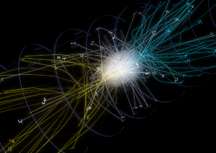January 22,2016
Antihydrogen remains neutral in ALPHA experiments
 |
|
Trajectories of antihydrogen atoms from the ALPHA experiment. (Photo courtesy of Chukman So/University of California, Berkeley) |
WEST LAFAYETTE, Ind. — The international collaborators of the ALPHA-2 experiment have measured the charge of antihydrogen to be zero with the greatest precision yet, narrowing the possibilities of where a difference between hydrogen and its antimatter counterpart could be found.
Francis Robicheaux, a professor of physics at Purdue University, is part of the international team of ALPHA scientists performing a series of experiments at the European Organization for Nuclear Research, or CERN, in Geneva, Switzerland.
"It is thought that matter and antimatter appeared in equal amounts after the Big Bang, but the Standard Model of particle physics offers no explanation for why antimatter is absent in the observable universe," he said. "We are pursuing a better understanding of antimatter and testing the Standard Model to see where a change may be necessary."
It is theorized that antimatter is made up of particles, called antiparticles, that are identical to ordinary matter particles, but with an opposite charge. Whereas a hydrogen atom is made up of a positively charged proton and negatively charged electron, an antihydrogen atom is made up of a negatively charged antiproton and a positively charged positron. However, it is thought that at some point there is another difference that breaks the symmetry between matter and antimatter, he said.
"If we find an asymmetry between matter and antimatter, it would provide tremendous insight into the fundamental physics of our universe," said Robicheaux, who has been a part of the ALPHA collaboration since 2006. "One difference could be that antihydrogen has a net charge, but it would be a very subtle difference, barely above zero, that could only be seen through extremely precise measurements. We must look very carefully to either discover the charge or effectively rule it out as the point of asymmetry."
The ALPHA collaboration reported a measurement of antihydrogen charge that was zero to nine decimal places. A paper detailing the results was published in the journal Nature and is available online.
The scientists use CERN's antiproton decelerator to study the trajectories of antihydrogen atoms released in the presence of an electric field. If the antihydrogen atoms had an electric charge, the electric field would deflect them and alter their trajectories, he said.
Robicheaux is part of a team of scientists who interpret the data collected from the experiments, calculate the limits of what can be measured and simulate what is happening in the experiment.
In this experiment the limits on the antihydrogen charge were found by simulating whether it could survive the manipulations in the experiment, he said.
"We showed that the charge of the antihydrogen would have to be more than a billion times smaller than the charge of an electron to survive," Robicheaux said. "Even though the charge measurement gave the expected result, we're motivated by the possibility of being surprised. There are a lot of possible measurements we can do and it would be momentous if one of them disagreed with current theories."
Writer: Elizabeth K. Gardner, 765-494-2081, ekgardner@purdue.edu
Source: Francis Robicheaux, 765-494-3029, robichf@purdue.edu
ABSTRACT
An improved limit on the charge of antihydrogen from stochastic acceleration
M. Ahmadi, M. Baquero-Ruiz, W. Bertsche, E. Butler, A. Capra, C. Carruth, C. L. Cesar, M. Charlton, A. E. Charman, S. Eriksson, L. T. Evans, N. Evetts, J. Fajans, T. Friesen, M. C. Fujiwara, D. R. Gill, A. Gutierrez, J. S. Hangst, W. N. Hardy, M. E. Hayden, C. A. Isaac, A. Ishida, S. A. Jones, S. Jonsell, L. Kurchaninov, N. Madsen, D. Maxwell, J. T. K. McKenna, S. Menary, J. M. Michan, T. Momose, J. J. Munich, P. Nolan, K. Olchanski, A. Olin, A. Povilus, P. Pusa, C. Ø. Rasmussen, F. Robicheaux, R. L. Sacramento, M. Sameed, E. Sarid, D. M. Silveira, C. So, T. D. Tharp, R. I. Thompson, D. P. van der Werf, J. S. Wurtele & A. I. Zhmoginov
Antimatter continues to intrigue physicists because of its apparent absence in the observable universe. Current theory requires that matter and antimatter appeared in equal quantities after the Big Bang, but the Standard Model of particle physics offers no quantitative explanation for the apparent disappearance of half the universe. It has recently become possible to study trapped atoms of antihydrogen to search for possible, as yet unobserved, differences in the physical behavior of matter and antimatter. Here we consider the charge neutrality of the antihydrogen atom. By applying stochastic acceleration to trapped antihydrogen atoms, we determine an experimental bound on the antihydrogen charge, Qe, of |Q| < 0.71 parts per billion (one standard deviation), in which e is the elementary charge. This bound is a factor of 20 less than that determined from the best previous measurement of the antihydrogen charge. The electrical charge of atoms and molecules of normal matter is known to be no greater than about 10−21e for a diverse range of species including H2, He and SF6. Charge–parity–time symmetry and quantum anomaly cancellation demand that the charge of antihydrogen be similarly small. Thus, our measurement constitutes an improved limit and a test of fundamental aspects of the Standard Model. If we assume charge superposition and use the best measured value of the antiproton charge, then we can place a new limit on the positron charge anomaly (the relative difference between the positron and elementary charge) of about one part per billion (one standard deviation), a 25-fold reduction compared to the current best measurement.

